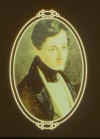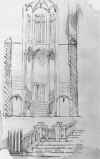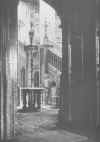| 1750 |
Bussy Mansel, the fourth and last Baron, dies without a male heir. The title becomes extinct and Margam, along with Oxwich and Penrice, passed through marriage into the Talbot family to the Reverend Thomas Talbot of Lacock Abbey, Wiltshire. He enjoyed his inheritance for a brief number of years, Margam passing to his son, Thomas Mansel Talbot. |
| 1768 |
Thomas Mansel Talbot sets out on a Grand Tour of the Continent, an accepted part of the eighteenth-century gentleman's education, returning home in 1772 to the Estate at Penrice, Gower to construct his new villa there. Only as it neared completion did his attention be directed to improvements at Margam. |
| 1786 |
Construction of the Orangery begins to the design of Anthony Keck |
| 1792 |
Viscount Torrington reports with horror that the chapter house now houses a stag - it's roof collapses in 1799 and an outstanding piece of medieval architecture was wrecked. |
| 1793 |
Completion of the Orangery.
Estate accounts record the final demolition of the dilapidated Tudor House by Thomas Mansel Talbot, now residing at his newly built villa at Penrice. When visiting the Orangery and Gardens the family lodged at Margam Cottage on the outskirts of the Park. |
| 1794 |
The gardens were fenced to keep out the deer and an entrance of stone piers and rustic gates was made. |
| 1800 |
The Citrus House was erected to house some of the famous citrus tree collection. |
| 1802 |
Lord Nelson, travelling through South Wales with Sir William and Lady Hamilton, visited the Orangery and gave the gardener who showed them around a three-shilling tip. |
| 1814 |
Estate map shows that Talbot achieved his aim of creating a Park for it illustrates the different areas called 'Great', 'Little' and 'Upper' Parks |
| 1820s |
 Plans to build a new house at Margam were commissioned by Christopher (Kit) Rice Mansel Talbot (1803 - 90), Thomas Mansel Talbot's son, who had Romantic ideas about the Park, its history and the style of house that he wanted. Plans to build a new house at Margam were commissioned by Christopher (Kit) Rice Mansel Talbot (1803 - 90), Thomas Mansel Talbot's son, who had Romantic ideas about the Park, its history and the style of house that he wanted. |
| 1830 |
 Work commences on the construction of Margam Castle, a romantic extravaganza designed by Thomas Hopper (1776-1856). Edward Haycock (1790-1870) of Shrewsbury was supervisory architect during this period and was also responsible for some work on the interior and exterior of the house, the stables, terraces and lodges. Talbot took a keen interest in the works and carefully supervised the expenses. Work commences on the construction of Margam Castle, a romantic extravaganza designed by Thomas Hopper (1776-1856). Edward Haycock (1790-1870) of Shrewsbury was supervisory architect during this period and was also responsible for some work on the interior and exterior of the house, the stables, terraces and lodges. Talbot took a keen interest in the works and carefully supervised the expenses. |
| 1837 |
The historic stone façade attributed to Inigo Jones, the Temple of the Four Seasons, is re-erected fronting a gardener's house, Ivy Cottage - this front is all that remains of the seventeenth century banqueting house.
The West driveway, including the bridge at the north end of the fishpond lake, was built. Also it is probable that at this time the gate piers were moved from the gardens to their somewhat odd position at the now west entrance. |
| 1840 |
The construction of Castle complete and works to stable and courtyards in progress.
Main driveway from the east constructed by C.R.M. Talbot.
Construction of the East Lodges commenced, designed by Edward Haycock, together with Middle Lodge and the West Lodge, which was demolished in 1975 to make way for the M4 motorway. |
| 1841 |
The marshy valley to the north of the gardens was dammed to form the present fishpond lake, the water used to supply the fountains on the Orangery Terrace.
The west end of the park was extended to include much of the public road and the village of Margam; the new model village of Groes was built at this time, designed by Haycock, but was also demolished for the M4 motorway. |
| 1852 |
The construction of the Orangery terrace.
Henry Fox Talbot, the pioneer photographer and a frequent visitor to Margam at this time, carried out several early experiments in the grounds of Margam Castle and succeeded in taking the earliest photographic views of the mansion. |
| 1876 |
The only son of Christopher R.M. Talbot dies as a result of a riding accident. |
| 1881 |
 The Prince and Princess of Wales, later Edward VII and Queen Alexandra, visited Margam on Monday, 17th October 1881. The Prince and Princess of Wales, later Edward VII and Queen Alexandra, visited Margam on Monday, 17th October 1881.
The couple stayed for luncheon after which the Princess planted a tree in the Orangery Gardens. |
| 1890 |
 Margam was inherited by Emily Charlotte Talbot. The Vine House is built and most of the greenhouses were replaced with new ones by Messenger & Co. of Loughborough, which have now all disappeared except the small one to the rear of the Citrus House. Margam was inherited by Emily Charlotte Talbot. The Vine House is built and most of the greenhouses were replaced with new ones by Messenger & Co. of Loughborough, which have now all disappeared except the small one to the rear of the Citrus House.
Engine house built. |
| 1891 |
Electricity is introduced into the Castle. |
| 1892 |
At the Castle, a Billiards Room was built over a small inner courtyard. Twyn-yr-Hydd House, with its separate dressed stone rusticated piered entrance was built as a home for Emily Charlotte Talbot's agent, Edward Knox. |
| 1902 |
A bamboo garden is established below the lake and a Pergola introduced to the south western part of the Orangery garden by Emily Charlotte Talbot. |
| 1918 |
Emily Charlotte Talbot dies and Margam was left in trust to her great nephew, a minor, John Theodore Talbot Fletcher whose father Captain Andrew Mansel Talbot Fletcher was a keen horticulturalist who helped to finance the plant hunting expeditions of Frank Kingdom Ward. Some of his introductions of rhododendrons and azaleas were planted at Margam, many of which still flourish. |
| 1926 |
New Pond was created by Captain Fletcher to relieve unemployment and improve the view from the house. |
| 1930 |
Captain Fletcher converts the old stable block into a squash court and garage, and creates a tennis court to the south east of the Castle. |